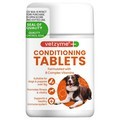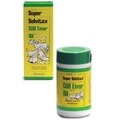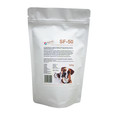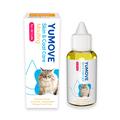Skin diseases, or dermatopathies, are relatively common in cats. The skin is the largest organ in a cat’s body, comprising up to ¼ of its body weight. This amazing organ provides a protective barrier to the environment and regulates body temperature, among other important functions. Your cats skin or coat can be a good indicator of their overall health.
Signs of skin allergies in cats, or signs your cat may have a skin problem:
- Excessive scratching, licking, or chewing of the fur
- Redness and swelling of the skin
- Loss of fur
- Scabby, scaly, or flaky skin
- Swellings or bumps on the skin
There are a number of causes of skin conditions in cats from parasites to allergies to endocrine disorders. Below are some of the most commonly seen problems.
 Flea Allergy Dermatitis (FAD):
Flea Allergy Dermatitis (FAD):
Fleas biting can be very irritating but some cats also become allergic to the fleas saliva causing a hypersensitivity reaction called flea allergy dermatitis. This leads to your cat intensively itching themselves causing hair loss, sores and scabs on the skin. Once the cat is hypersensitive just one bite from a flea can trigger the allergy. You can check your cat for fleas by parting the fur and looking for small moving brown specks or flea dropppings which appear like bits of dirt or black pepper. It is important to treat your cat regularly with a good quality flea treatment to avoid cat skin allergies. Remember to treat the household too since fleas can hide in your cats environment and jump back onto them as they go past.
Ringworm:
Ringworm is a fungal infection that can affect the skin, hair and nails of cats. It is highly contagious and spreads easily to other pets and people in the household! Classic signs of ringworm are circular areas of scaly, hair loss that look red and inflammed in the centre. However severe infections can spread over the cats whole body. Ringworm can spread directly through contact with an infected animal or indirectly via contaminated bedding, food bowls, toys etc. Ringworm spores can survive in the environment for up to a year so it is important to thoroughly clean and disinfect anything your cat has come into contact with if they have contracted ringworm. Treatment of the cat depends on the severity of the infection but usually involves an oral antifungal liquid and/or shampoo. Trimming long-haired cats can also be helpful to remove spores.
Allergies:
 Like dogs cats can suffer from allergies in the environment such as pollen, cleaning products and cigarette smoke. Less commonly they may develop a hypersensitivity reaction to certain foods that can result in itchy skin. Once you have determined the allergen with the help of your vet the best treatment is avoidance of the allergen. However this is not always possible and certain medications may be used to help control the itching.
Like dogs cats can suffer from allergies in the environment such as pollen, cleaning products and cigarette smoke. Less commonly they may develop a hypersensitivity reaction to certain foods that can result in itchy skin. Once you have determined the allergen with the help of your vet the best treatment is avoidance of the allergen. However this is not always possible and certain medications may be used to help control the itching.
Cat Bite Abscess:
Cat bite abscesses are particularly common at this time of year as increased daylight and temperatures lead cats to roam further resulting in fighting with neighbouring cats. Many nasty bacteria live in the mouths of cats which are injected into the deep skin tissues when fighting cats bite each other. An infection ensues which usually results in an abscess. Often there will be a lump with bite marks but this can often be covered by hair and difficult to see. Other signs your cat has an abscess are a foul smell, lethargy, resenting being picked up, lameness (depending on where the abscess is). Treatment is usually with antibiotics and painkillers. However it is sometimes necessary to open, drain and flush the abscess. Uneutered cats are much more likely to roam and get into fights so it is highly recommended that you have your cat neutered to try to reduce the incidence of cat bite abscesses.
If you have found this article helpful, you might be interested to read our other related articles: Allergy related itchy skin, Skin allergies in dogs, Seasonal allergies and itchy skin, How to treat adverse food reactions in dogs, Dealing with food allergies, Elimination diets: a simple guide to identifying a food allergy.
Written by: Dr. Sophie Meers BVSc MRCVS









